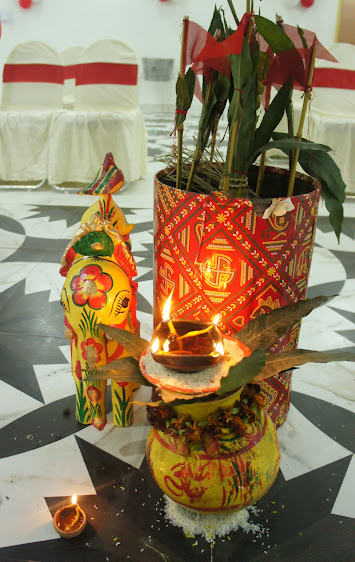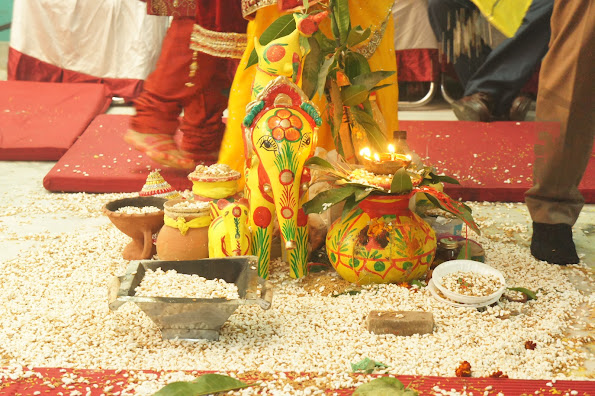Pachyderms of Prosperity: Clay Elephants in Bihari Wedding Traditions and Chhath Puja
Historical Background:
For Bihar's culture and history, elephants and pottery have both been extremely significant. Following the Later Vedic Period (1000-600 BCE), Bihar provided a fertile ground for the emergence of the Shramana movement by facilitating the upsurge of several heterodox sects such as Buddhism, Jainism, Lokayatism, Ajivikaism, etc. during the Age of Mahajanapadas (from the sixth century BCE to the fourth century BCE). The territory also saw the rise of the first empire in India i.e. the Magadha empire whose founder King Bimbisara (c. 544 BCE- 492 BCE) of the Haryanka dynasty is considered to be the first emperor of India. It is also known for the advent of the first pan-Indian empire, the Mauryan empire (c. 321 BCE-181 BCE). These two strong empires made use of the area's abundant forest resources. Elephants that had been captured from the forests were tamed and trained to fight in battles, storm strongholds, and march across marshlands and other terrain devoid of roads and other means of communication. Elephants formed an integral part of their army.
Elephants featured in marriages of state too. After being vanquished by Chandragupta Maurya (founder of the Mauryan empire), Seleucus Nicator (founder of the Seleucid empire) was forced to sign a peace treaty in 303 BCE with him. As per the contract he was to cede Aria (Herat), Arachosia (Kandahar), Gedrosia (Baluchistan) and Paropanishad (Kabul) to Chandragupta. He married Chandragupta with his daughter. He received 500 war elephants in exchange. Thus, elephants became synonymous with the notion of power, authority and royalty in the region and gradually in the whole of India. Just as in the northern and north-western regions of India, Mughal royal insignias such as sarpech, kalgi, etc., defining dominance and opulence became part of marriage ceremonies, Bihari marriage too includes symbols exhibiting the notion of prosperity and power.
By the Mauryan period, the use of potter's wheel became widespread, and a great variety of pottery was accessible at this time. Northern Black Polished Ware (NBPW) was the most notable kind. Its highly polished glaze covering, which comes in a variety of colors from jet black to deep grey to metallic steel blue, was some of its distinguishing characteristics. Its principal centers were at Patliputra (present-day Patna) and Koshambi. NBPW was made in small quantities using a particular process and traded to distant locations. Since it was a luxury item, it was used solely by the elites. Consequently, it strengthened the social hierarchy, making it highly significant. The tradition of pottery making still persists in the region on a large scale. Every village, town, and district have evolved an own style of pottery. The creation of toys and images is strongly linked to religious rites and seasonal celebrations.
Glimpses of Historical and Cultural Amalgamation in Rituals of Bihar:
The appearance of clay elephants in the Bihari marriage highlights the fusing of the symbol of regality and strength and the emblem of prosperity. The purpose of the use of such symbols is to foster an environment of abundance, gaiety and aspirations.
The female members of the bride's family purchase the clay elephant, but the bridegroom's family may also buy it from the potter's house. Although money alone cannot buy it; the potter who is selling it must also be presented with the offerings of clothing, utensils, and other similar items in addition to payment as 'shagun'.
The clay elephant has a diya (small clay oil lamp) perched on top of its head and a kalash (pot) affixed to its back. On the day the bridegroom visits the bride's house with his family, friends, and relatives to tie the knot, it is revered during the mandap puja.
In Bihar, clay elephants can also be seen atop roofs, symbolizing marriage.
Handcrafted elephant is also seen during the Chhath celebration of Bihar which is observed after the festival of Diwali. It is offered as a votive offering at Chhath Puja (dedicated to the worship of the sun god). When a wish is granted by the grace of Chhathi Maiya, the individual performing the Chhath Puja offers it to her. It is worshipped by setting it in the center of a kosi which is made of sugarcanes. It is venerated at house as well as at the ghat (bank of a sacred river) and on the final day of the celebration, the elephant is flown into the river in the morning following the offering of arghya (a deity-worshipping offering of several ingredients).
Bihar's usage of crafted elephants for religious festivals like Chhath Puja and weddings is a prime example of the close relationship between history, traditional artistry, culture, and spirituality. These clay elephants, which stand as witnesses to time, represent the rich artistic legacy of Bihar and act as concrete links to a cultural continuum that combines the past and present in a seamless manner.










Comments
Post a Comment